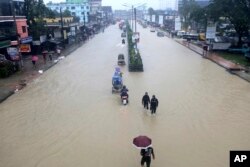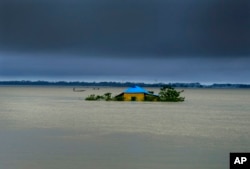It is not uncommon for catastrophic floods to have washed homes, drowned paddy fields and stranded millions of people in northeastern India and Bangladesh over the past few weeks. Floods during the South Asian monsoon season occur virtually every year. ..
What is unusual is that the vast lands of both countries disappeared underwater earlier this year.
"The peak of the flood occurs in July and August when the monsoon is in full swing, but this year heavy rains began to fall in May and a disaster occurred," said Assam. Tritha Prasad Saikia, co-director of the Northeastern Impact Development Association, a voluntary group that does the work, said.
"The rainfall calendar has changed to increase the intensity and magnitude of floods," said Saikia, who grew up in the state.
Two serious floods have already occurred in both northeastern India and Bangladesh. Once in May and once this month.
Floods have to deal with more unpredictable and longer devastation spells as South Asia's most vulnerable communities change monsoon patterns and extreme weather events become standard rather than exceptions. It led to a warning from a climate expert that it might have to be.
"The widespread floods caused by this year's pre-monsoon heavy rains are unprecedented. This change in monsoon patterns is due to climate change. A study by the Balti Institute for Public Policy, India. Anjar Prakash, who was responsible and contributed to the report of the UN Intergovernmental Panel on Climate Change, said: “And it will change.“ And this is undoubtedly revealed by the flood.
Instead of a stable distribution of rain during the monsoon season from June to September, shorter periods of torrential rain are becoming more common, experts say. .. For example, according to the India Meteorological Department, Assam had about twice as much rainfall in the first three weeks of June compared to the average rainfall during this period.

Floods are not the only climate change event affecting one of the most densely populated areas in the world. Experts also point out the brutal heat waves that began burning the vast northern plains of South Asia as early as March this year, as well as the cyclones and urban floods that regularly hit coastal areas.
In Assam, northeastern India, where the entire village is swirling floods, authorities say more than 5 million people have been affected and more than 80,000 have been evacuated to relief camps. .. Over 100 people have died.
In Bangladesh, millions have been affected by the floods, but about 60 people have died in monsoon-related events. No such violent floods were seen in the country's most affected areas, Silet and Sunamgangji. In decades.
In both countries, disaster personnel and the military have begun rescue operations, despite authorities and support agencies distributing food and drinking water to refugees. However, damaged roads and bridges make this task difficult.

"We have relief supplies, but the most damaged communities due to lack of access to the worst-damaged areas. I'm not in a position to reach. "Saikia said.
Among those seeking help is Pabitra Bora, who works at the Assam hydropower plant and has recently flooded a three-room home.
"Water spewed out at night. There was no warning or time to save anything. Some neighbors brought a boat and we ran away," Bora told VOA. rice field.
He evacuated to the library with his family, but says the floods robbed him of everything. "I don't know what my future will be. For now, it's difficult to even eat twice a day."
However, early relief may not be visible. The Brahmaputra River, which flows through northeastern India to Bangladesh, has exceeded dangerous levels in some places, even though the monsoon may increase its pace in the coming weeks.
"It can be a long-term crisis," Saikia said. "The embankments and roads are already damaged. How will we repair them in time for the heavier rains that may occur within the next two months?"
Climate change The impact of the events caused by is particularly severe in areas where millions of people rely on cultivating small lands for nutrition.
In Assam, the first flood occurred in May as people were harvesting rice. Much of the harvest was washed away. In India, heat waves earlier this year reduced wheat yields and yields in March, and the government has banned wheat exports.
Last month, the International Food Policy Research Institute reported that India's food production could decline by 16% and climate change could increase the number of people at risk of hunger by 2030. there is.
“The rapid changes caused by climate change have been going on for about five years, but we haven't taken appropriate steps to plan them,” Prakash said.
"As a result, people in climate-sensitive areas are caught up in climate catastrophes every year and are stuck in a virtuous cycle of poverty."


